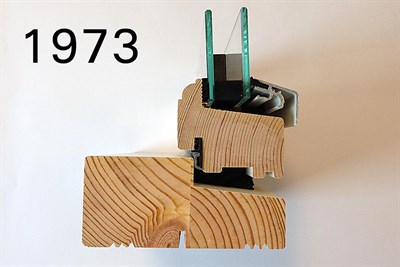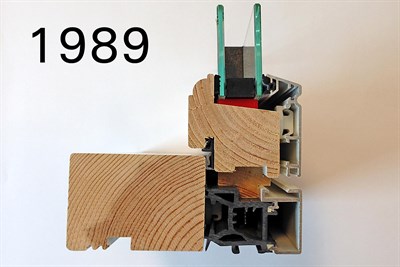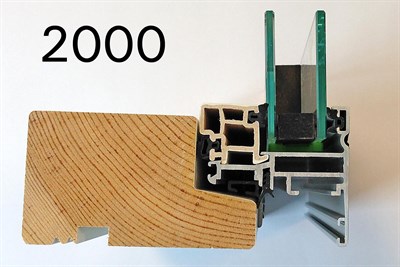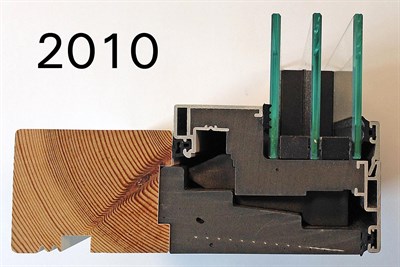The figures below illustrate the general development trends
for window sash and frame in Scandinavia within the last 40 years
with examples from Winsmart project partner IDC. Up until the
1970's window frames were largely produced in wood, primarily
heartwood from Scots pine. The purpose of the sash/frame was to
hold the glazing in place and allow the window to be opened.
Insulation properties was not a major driving force for development
at this stage.

In the 1980's, maintenance and service life became important
development drivers. In windows, wood is viewed as a high
maintenance material. Wood is susceptible to biodegradation by
decay fungi (rot) and to dimensional instability due to its
hygroscopic properties. Wood windows therefore require a relatively
high level of maintenance - in the form of surface treatment
(painting) at regular intervals - to be kept sound. Consequently,
window producers gradually began to limit the amount of wood in the
parts of the window exposed to the weather. The figure below shows
a window with an aluminum profile attached on the outside of both
sash and frame to protect the wood from direct exposure to the
elements. The aluminum profile increases the durability of the
window and lowers the maintenance requirements for the consumer.
However, the main part of both sash and frame is still wood which
was typical for the Scandinavian window market at the time.
Elsewhere in Europe, especially in in Germany, the development
trend went towards eliminating the use of wood in windows
altogether, and to produce window sash/frame exclusively in PVC or,
later on, aluminum.

Mainly driven by architects, sash and frame design became an
important development factor from the 1990's onwards. The sash and
frame part of the window should be as slim as possible to increase
the amount of light per window opening and to make the window look
more elegant from the outside. This is evident in the figure below,
which shows a considerably slimmer design compared to the figures
above. The sash is now designed to be an extension of the frame
rather than closing in on top of the frame. The trend of limiting
the use of wood is continued and the sash is now constructed of
pure aluminum with no use of wood. Still, insulation properties and
energy efficiency were not the main development drivers.

From the turn of the millennium to the present day, energy
efficiency has grown increasingly important as a development factor
for window sash/frame design and is now perhaps the main driver for
sash and frame development. The development has been partly market
driven because the ever-increasing energy costs coupled with
increased environmental consumer awareness has resulted in an
increased demand for energy efficient windows. In addition,
legislative action has put minimum demands on the energy efficiency
of windows in newly constructed buildings.
The figure below shows a profile of FUTURA+, a state-of-the
art Scandinavian window from IDC. The entire sash and the outer
part of the frame is made of rigid poly-urethane foam (PUR) with a
density high enough to give it the structural properties needed to
support the weight of the triple glazing and to give the whole
window structural stability. At the same time, PUR provides good
insulation properties due to the relatively low thermal
conductivity (λ-value) of PUR foam compared to wood, PVC, and
aluminum. Two versions of FUTURA+ is produced: one for the
Scandinavian market opening out and another for the central
European market opening in. The Scandinavian version (below) is
designed with wood on the interior part facing the consumer while
the central European version has aluminum facing the customer.

The U-values of the FUTURA+ window as a whole (Uw) is
0.87 for the Scandinavian version opening out and 0.83 for the
central European version opening in with triple glazing
installed.
Sash and frame in Winsmart
As described above, current state of the art windows have a
Uw-value in the range of 0.8. With this background, the
winsmart objective of reaching a Uw-value of 0.3 is very
ambitious, especially when you consider the additional objectives
of lower weight, reduced embodied energy, and lower production cost
compared to state-of-the-art.
The window sash and frame design should enable the overall
winsmart objectives as well as provide structural support for the
VIG and the switchable technology. These goals will be achieved
through use of the latest technology materials with extremely low
thermal conductivity.

This project has received funding from the European
Union Seventh Framework Programme (FP7/2007-2013) under grant
agreement n° 314407.